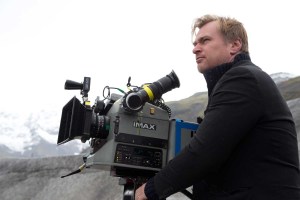
Set in a post-apocalyptic future earth in which the planet’s ecosystem is failing, warranting deep space exploration, director Christopher Nolan’s ninth feature film, the science-fiction epic Interstellar positions science as its key element in a manner unlike many studio films to date. Indeed, akin to the rare breed of sci-fi picture found in features such as 2001: A Space Odyssey, Contact, Solaris, Gravity and Nolan’s own Inception, this new film takes the audience on an unexpected journey to new worlds, different dimensions and sharply shifting time periods.
Impeccable craftsmanship is at the forefront of Interstellar, due in large part to Nolan’s key collaborators. In lieu of shooting against greenscreens, Nolan suggests exterior space and newly discovered worlds with a combination of location cinematography in Iceland and the practical projection of celestial backgrounds to enhance practical sets. Surely, Hoyte Van Hoytema’s cinematographic choices present Interstellar’s visages as beautifully futuristic in their conception and renderings. Additionally, Nathan Crowley’s production design mirrors Van Hoytema’s work in its presentation of feasibility in space travel and alternative universes. Interestingly, while Van Hoytema is new to Nolan’s crews, Crowley collaborated with the director since Insomnia, working on his entire Batman trilogy.
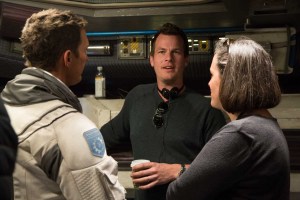
Additionally critical to Interstellar’s sense of realistic aesthetics are co-visual effects supervisors Andrew Lockley and Paul Franklin, both of whom worked on Nolan’s Batman trilogy. Their effects in Interstellar seamlessly blend with both cinematography and set design, amounting to an otherworldly experience for the viewer.
Rounding out the visual material, Mary Zophres’ Interstellar costumes presented a sense of tangibility and specificity in a science-fiction film unlike those seen onscreen since 2001: A Space Odyssey some 46 years ago. Though a newcomer to Nolan’s team, Zophres has been designing cinema costumes for a full 20 years to date.
Certainly, though Interstellar is set amidst a dying earth, much of the ensuing story is hopeful and optimistic. According to Jonathan Nolan, Christopher’s brother and the original screenwriter on the project, in 2006, he first conjured childhood memories of the United States’ initial 1960s and 1970s space travels, including missions to the moon. “We get to a certain point where all those Americans… landed on the moon,” he said. “We grew up watching the rocket launches. You get to a certain age and you realize, there’s no money there. We’re not going back, and that moment felt like the melancholy or the sadness of that. If you charted our evolution as a species in terms of altitude, we had peaked in 1973. And that was kind of a sad realization. And so I had this optimism of what’s the next moment in which we start to journey once again.”
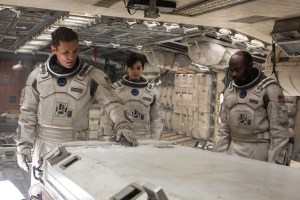 For the elder Nolan, his entry to the project began when the originally vested director Steven Spielberg left the project. “I was talking to Jonah [Jonathan Nolan] about the script he was working on at the time and what it was about, and it just sounded incredibly exciting,” said Christopher Nolan. “And what it was that got me is the way Jonah had originally explained to me that it’s really about an inevitability. I mean we are going to leave this planet at some point, further than we have; we are going to go beyond the moon. We are going to go Mars. We all kind of know that on some level I think, actually. So there in inevitability to human evolution, and this being the next step. The idea with this story, you can view the earth as a nest and one day we leave the nest. Or the earth is the egg and the egg hatches and we go. And that to me seemed like a massive idea that hadn’t been addressed in movies. And that’s the kind of opportunity you’re looking for.”
For the elder Nolan, his entry to the project began when the originally vested director Steven Spielberg left the project. “I was talking to Jonah [Jonathan Nolan] about the script he was working on at the time and what it was about, and it just sounded incredibly exciting,” said Christopher Nolan. “And what it was that got me is the way Jonah had originally explained to me that it’s really about an inevitability. I mean we are going to leave this planet at some point, further than we have; we are going to go beyond the moon. We are going to go Mars. We all kind of know that on some level I think, actually. So there in inevitability to human evolution, and this being the next step. The idea with this story, you can view the earth as a nest and one day we leave the nest. Or the earth is the egg and the egg hatches and we go. And that to me seemed like a massive idea that hadn’t been addressed in movies. And that’s the kind of opportunity you’re looking for.”
As with the Christopher Nolan films The Prestige and the second two of his Batman films, brother Jonathan would become a co-writer with director Christopher. “Every collaboration I’ve had with Jonah has been different,” said Christopher, 44, six years older than his screenwriter sibling, “because of different circumstances and how we would work together. This one was very unique in that he worked for a very long time on it without me involved.”
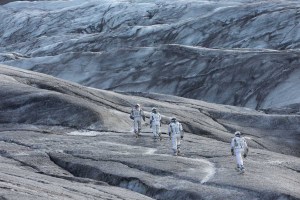 For producer Emma Thomas, who has served in that capacity on all nine Christopher Nolan features, the concept of embarking on the team’s first true sci-fi project became intriguing when Jonathan Nolan brought it to Chris. “Obviously we were familiar with the project when Jonah was writing it, and we were not involved,” she said, “but I thought it was fun to make a movie that heads out into space, which is something that we’ve never done before. I loved the fact that this is a project that deals with the sort of excitement and adventure of space travel, but at the same time has a very intimate story and is so relatable. I love the big ideas, the big questions that it poses. On the face of it, you would think a film or a story about us having to leave the earth would be sort of a depressing one, but the thing that Jonah’s draft had, and Chris continued with, there’s a real hope to it and a real sense of what we have as humanity – that is unlike any other species – which is the resourcefulness and sense of adventure and resilience. And I found that to be an incredibly exciting proposition.”
For producer Emma Thomas, who has served in that capacity on all nine Christopher Nolan features, the concept of embarking on the team’s first true sci-fi project became intriguing when Jonathan Nolan brought it to Chris. “Obviously we were familiar with the project when Jonah was writing it, and we were not involved,” she said, “but I thought it was fun to make a movie that heads out into space, which is something that we’ve never done before. I loved the fact that this is a project that deals with the sort of excitement and adventure of space travel, but at the same time has a very intimate story and is so relatable. I love the big ideas, the big questions that it poses. On the face of it, you would think a film or a story about us having to leave the earth would be sort of a depressing one, but the thing that Jonah’s draft had, and Chris continued with, there’s a real hope to it and a real sense of what we have as humanity – that is unlike any other species – which is the resourcefulness and sense of adventure and resilience. And I found that to be an incredibly exciting proposition.”
Amid the science and technology which predominantly runs throughout Interstellar’s second and third acts, the film has a humanistic core, especially among Matthew McConaughey’s lead character, the pilot Cooper, and his children, who are presented at different periods in their lives. “When I first looked at Jonathan’s draft, it was very clear– at the heart of his story there was this great set of characters, this great relationship,” said Christopher Nolan. “And we found that the more you explore the cosmic scale of things, the further out from everything else you went. Then more of the focus came down to who we are as people and the connections between us. I got to reap the benefits of many years of research and development on [Jonathan’s] end. And I got to make it my own, which is a fun thing to be able to do, and hopefully he is happy with the finished product.”
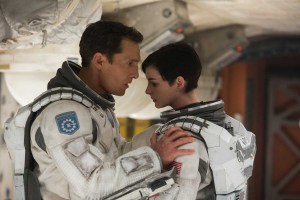 Another recurring Christopher Nolan staple is Hans Zimmer’s music, though on Interstellar, their approach was markedly different from earlier collaborations. “Just to speak to the creative approach, one of the things I did was I didn’t want [Zimmer] to know what the genre was when he started working,” said Christopher Nolan. “And so before I had started working on the script, I wrote out a page of what I considered to be… the relationships, the idea of the father. How it was to be with his daughter, his children. And I gave it to Hans, and I said, ‘Work on that for a day, and give me what you got at the end of the day,’ and I’ll either see if it was a good score, and indeed the finished score came from that particular creative act. And that’s an illustration to the approach we tried to take in terms of keeping this about the humanity, and using the exploration of the universe as really a lens through which to view ourselves as human beings.”
Another recurring Christopher Nolan staple is Hans Zimmer’s music, though on Interstellar, their approach was markedly different from earlier collaborations. “Just to speak to the creative approach, one of the things I did was I didn’t want [Zimmer] to know what the genre was when he started working,” said Christopher Nolan. “And so before I had started working on the script, I wrote out a page of what I considered to be… the relationships, the idea of the father. How it was to be with his daughter, his children. And I gave it to Hans, and I said, ‘Work on that for a day, and give me what you got at the end of the day,’ and I’ll either see if it was a good score, and indeed the finished score came from that particular creative act. And that’s an illustration to the approach we tried to take in terms of keeping this about the humanity, and using the exploration of the universe as really a lens through which to view ourselves as human beings.”
Echoing Christopher’s sentiments, Jonathan Nolan noted how his script dealt in not only space exploration but also the concept of shifts in time and dimensionality without losing a mandatory human connection. “What I was struck by was Einstein as a fascinating figure who didn’t have any instruments. He didn’t use telescopes,” Jonathan Nolan stated. “He used his mind to try and understand the universe, and you’d read these thought experiments that he’d come up with. If you want to explore these bigger questions, then you have to think proportionately in the opposite direction in terms of making sure it’s grounded in human experience.”
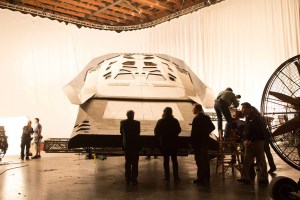 McConaughey, whose character is the pilot in charge of the story’s key space mission and serves as the audience’s surrogate throughout Interstellar’s extensive narrative, expressed his similar feeling of gravitating towards the human element of the screenplay. “It was apparent to me early on that this was about family,” McConaughey said. “This was about parents and children. And I think that is obviously where the aorta of the film emotionally exists. Even if you’re not parents, you have parents and you’ve been in those situations, where there is a certain kind of goodbye. Now there’s nothing that is as extreme as this, but that’s what I think everyone latches onto is the common denominator that everyone understands. As Chris said earlier, ‘The further out there we go, the more we find out and learn that it’s about you and me.’”
McConaughey, whose character is the pilot in charge of the story’s key space mission and serves as the audience’s surrogate throughout Interstellar’s extensive narrative, expressed his similar feeling of gravitating towards the human element of the screenplay. “It was apparent to me early on that this was about family,” McConaughey said. “This was about parents and children. And I think that is obviously where the aorta of the film emotionally exists. Even if you’re not parents, you have parents and you’ve been in those situations, where there is a certain kind of goodbye. Now there’s nothing that is as extreme as this, but that’s what I think everyone latches onto is the common denominator that everyone understands. As Chris said earlier, ‘The further out there we go, the more we find out and learn that it’s about you and me.’”
In point, Interstellar has a nearly equal share of massive sequences in space along with interpersonal character-oriented moments. “A lot of it was extremely intimate,” said Christopher Nolan. “A lot of it was one person in a room, not even two people in a room. I get to do that, and I get to do action adventure – with this sort of film, I get to do both. I get to do these thrilling action set pieces that you try and do on this scale of things. I try not to be particularly self-conscious in my choices, but with this film, I felt I had the freedom to try to put a lot of different elements together, and try out a lot of different things that I am interested in. And in terms of scale, what that resulted in is getting to do huge things, outlandish things, and then getting to do very intimate personal things. For me, that is the best of both worlds as a director.”
 To ground the movie in a scientific base, first Jonathan then Christopher Nolan consulted American scientist Kip Thorne, who is an executive producer on the project
To ground the movie in a scientific base, first Jonathan then Christopher Nolan consulted American scientist Kip Thorne, who is an executive producer on the project
“[Thorne] is a great resource in terms of knowing everything there is to know about the real physics: of what is theorized and what is known about the issues,” said Christopher Nolan. “I had the advantage of coming to the project late and looking at what these guys have done. I spent a lot of time in my work on the script, choosing what I could grab a hold of, and then I found working with Kip to be very liberating because it was more an exploration of ideas with him. What’s plausible? Where could we go here? Where could we go there? I found it very exciting to work with him on that.”
With Thorne as a key advisor and Christopher Nolan’s revision of brother Jonathan’s Interstellar script, Christopher set about preparing the large-scale project. “We did a lot of research before we designed the ships, before we figured out how we were going to film it,” said Christopher Nolan. “One of our greatest resources was IMAX and their relationship with NASA, because over the last 30 years they have the same cameras that we used. They’ve been in orbit, they’ve shot the international space station, repairs and all these things, and they have this incredible library footage. One of the first things we did, is we got a DP, a designer, VFX supervisor, we went and rented a big IMAX screen and projected these films all in one day. And watched as many of them as we could, to immerse ourselves in the feeling of the detail to be correct. We tried to get the appropriate textures of what this kind of spacecraft would need to be. That weird tension between the physical intimacy of a space ship and the fragile nature of the industrial quality of it, and then the cosmic scale of where it is going.”
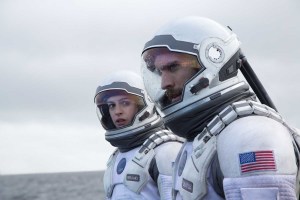 For Interstellar’s intricate principal photography period, the production shot on location in Iceland, in various spots in Alberta, Canada, in several locations throughout Southern California, and on stages at Warner Bros. and Sony Pictures. After wrap, Nolan and editor Lee Smith, who has been with Nolan since Batman Begins, began the considerable task of cutting the film and enhancing practically-achieved effects material with digital effects shots and composites, the majority of which were delivered by the vendor Double Negative.
For Interstellar’s intricate principal photography period, the production shot on location in Iceland, in various spots in Alberta, Canada, in several locations throughout Southern California, and on stages at Warner Bros. and Sony Pictures. After wrap, Nolan and editor Lee Smith, who has been with Nolan since Batman Begins, began the considerable task of cutting the film and enhancing practically-achieved effects material with digital effects shots and composites, the majority of which were delivered by the vendor Double Negative.
After much anticipation, with Interstellar finally debuting on Nov. 7, screening in 70mm IMAX in select theaters, Christopher Nolan concluded by underscoring the sense of hope that he wishes his film communicates en masse to audiences. “Space exploration to me always represented the most hopeful and optimistic endeavor that man is ever really engaged in,” he said. “The hope, the optimism of that, is something that feels like we are in need of again. I feel very strongly that we are at a point now where we need to start looking out and exploring our place in the universe more.”





